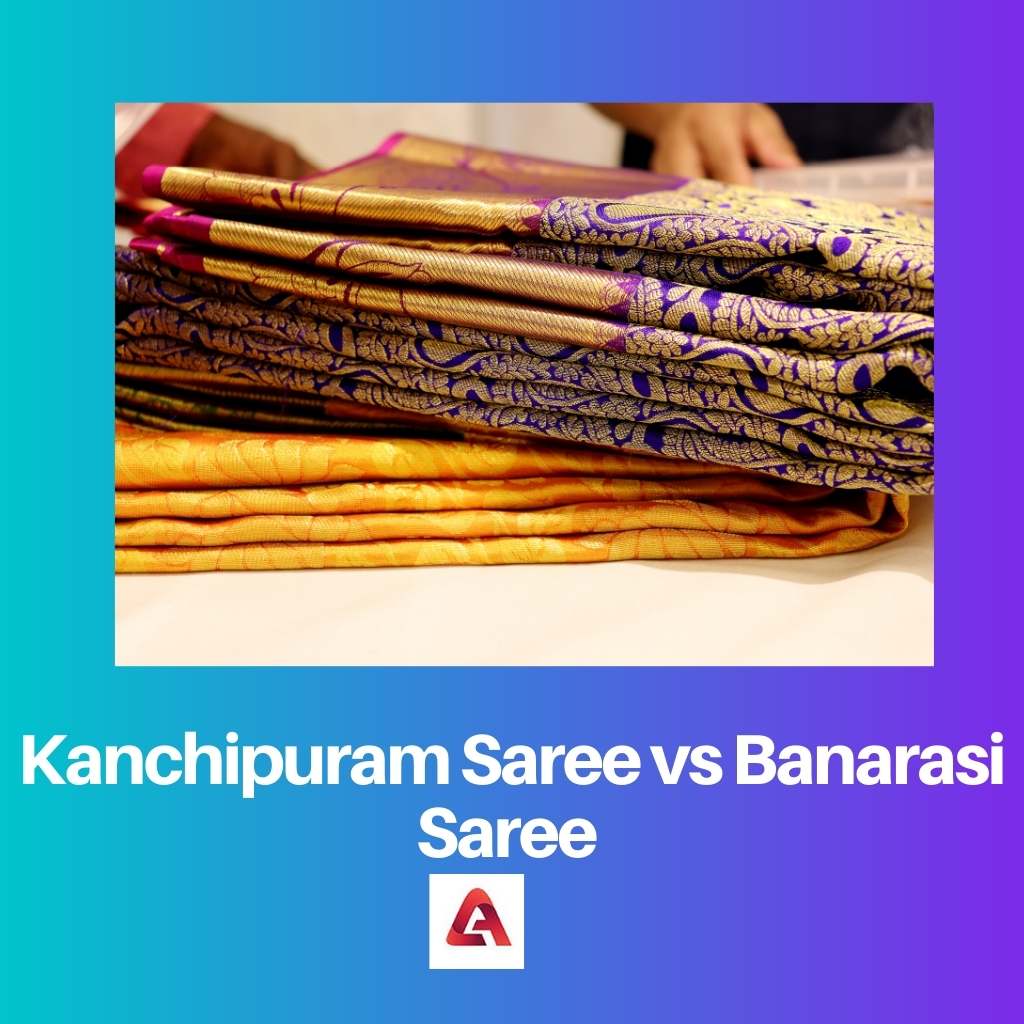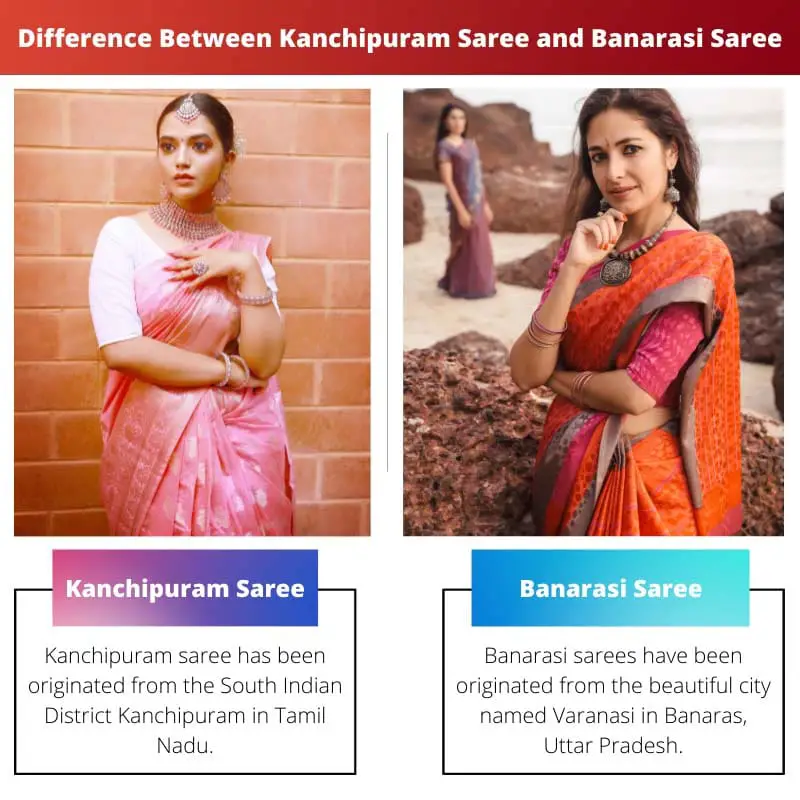Saree is commonly known to be the traditional attire of India. Almost every other woman knows how to wear a saree. It can be said it is a hereditary attire of India where a mother teaches there daughters to wear a saree, and it passes from one generation to the other. Also, in almost every other traditional occasion or festive season, such as marriage, engagements, pujas, etc., women wear sarees.
The most common and easiest way of styling a saree is by draping it around the waist, and one end of the saree is pleated around one side of the shoulder. There are various kinds of saree available in India that represent a uniqueness of their own. Here, Kanchipuram Saree and Banarasi Saree are among the other sarees.
Key Takeaways
- Kanchipuram sarees originate from South India and feature intricate weaving and high-quality silk.
- Banarasi sarees come from North India and are known for their fine silk, gold and silver zari work and detailed motifs.
- Both sarees represent traditional Indian craftsmanship and are popular for weddings and special occasions.
Kanchipuram Saree vs Banarasi Saree
Kanchipuram sarees, originating from the Kanchipuram region in Tamil Nadu, India, are renowned for their rich quality, vibrant colors, and intricate zari work. Banarasi sarees, from Varanasi in Uttar Pradesh, are known for their fine silk fabric, opulent embroidery, and detailed gold or silver brocade.

Kanchipuram saree is an elegant silk saree that has been originated in the South Indian state called Tamil Nadu. The saree is named after the small district of Tamil Nadu, Kanchipuram. In short, the name Kanchipuram saree itself represents the place of its originality. Kanchipuram saree also has an alternative name, and that is Kanjivaram saree, this saree is also famous for this name. Kanchipuram saree is famous and commonly worn by South Indian brides on their wedding day.
On the other hand, the Banarasi saree is a famous and elegant silk saree that has been originated from the State of Uttar Pradesh and from the beautiful city named Varanasi and commonly known as Banaras. Here, the city name also represents the saree’s name. Generally, Banarasi sarees have a very heavy and royal look, and hence it, is commonly worn on auspicious occasions such as marriage or any other festive season.
Comparison Table
| Parameters of Comparison | Kanchipuram Saree | Banarasi Saree |
|---|---|---|
| Origin | Kanchipuram saree has been originated from the South Indian District Kanchipuram in Tamil Nadu. | Banarasi sarees have been originated from the beautiful city named Varanasi in Banaras, Uttar Pradesh. |
| Fabric Types | Generally, the Kanchipuram saree is available in three types of fabrics namely, and they are pure silk plus pure zari, pure silk plus textile/half fine tested zari, and last but not least polyester/silk mix plus pure zari. | Generally, Banarasi sarees are available in four fabric types and they are pure silk (Katan), Shatti, Organza (Karo), and Georgette. |
| Colors | Kanchipuram sarees are available in bright and royal colors. | Banarasi sarees are available in light and subtle colors. |
| Price | Kanchipuram sarees can be considered to be pricey. | Banarasi sarees can be considered less pricey as compared to the Kanchipuram saree. |
| Design/Pattern | Kanchipuram sarees have the design of temples, motifs, stripes patterns, etc. | Banarasi sarees have a more floral design that is of flowers and leaves. |
| History | Kanchipuram sarees have a history behind their origin. According, to the sources it is said that the Kanchipuram silk weaver was the offshoots of Markanda, who himself weaved clothes for the Gods. | Banarasi sarees have a history, of its origin that the floral design on the sarees is partially inspired by the Mughals. |
| Identification of the Real Saree | The best way to identify a real Kanchipuram saree is by burning a thread from the saree. If the thread smells like burnt leather or hair, that means the saree is 100% real and not fake. | The best way to identify a real Banarasi saree is by looking at the reverse side of the saree. If the saree is real then it would have floats inside the wrap and weft grids. |
What is Kanchipuram saree?
Kanchipuram saree is a special kind of saree that is only found in India and no other places in the world. The Kanchipuram saree is made of a special kind of mulberry silk, and one more special thing about this saree is that the weaver’s hands only manufacture it, and no other machinery is used for manufacturing it. Therefore, it is a handloom saree. Kanchipuram saree has been originated from the South Indian District of Kanchipuram in Tamil Nadu. And this place is only famous for its saree.
Kanchipuram sarees are available in various kinds of fabrics and can be chosen by the customers accordingly. Generally, the Kanchipuram saree is available in three types of fabrics: pure silk plus pure zari, pure silk plus textile/half fine-tested zari, and last but not least, polyester/silk mix plus pure zari. Each fabric has its versatility. Also, these sarees are usually available in bright and royal colors, giving them a luxurious and chic look.
Kanchipuram sarees can be considered pricey and fall under high-end sarees. These sarees have the design of temples, motifs, stripes patterns, etc. And, hence makes it is expensive because of these fine designs and patterns. According to the sources, it is said that the Kanchipuram silk weaver was the offshoot of Markanda, who himself weaved clothes for the Gods. In recent years there have been many duplicates of sarees manufactured in the name of Kanchipuram sarees, and therefore to detect whether one is real or fake, the best way is by burning a thread from the saree. If the thread smells like burnt leather or hair, that means the saree is 100% real and not fake.

What is Banarasi saree?
Banarasi saree is a famous and elegant type of saree. Its elegant and classy look gives it a rich look to the women who wear them. Generally, these sarees are worn on the occasions such as marriages and especially by the bride as the main wedding saree. These sarees are also worn on festive occasions as well. Banarasi sarees originated from the beautiful city of Varanasi in Banaras, Uttar Pradesh. Banaras is famous as a religious city and for the Banarasi sarees. Tourists, while visiting this beautiful place, tend to buy this saree. Banarasi sarees are available in four fabric types: pure silk (Katan), Shatti, Organza (Karo), and Georgette.
Banarasi sarees are available in light and subtle colors. Therefore, it can be worn not only during marriages or festive reasons but for everyday purposes also. Women who like to dress up in a saree can use it well. Another plus point of Banarasi saree is that they are more affordable than other handloom silk sarees.
These sarees have a floral design on them with great color combinations. Banarasi sarees have a history of its origin, and the Mughals partially inspire the floral design on the sarees. Therefore, the weavers took inspiration from the Mughals. There are many fake sarees in the name of Banarasi saree, and therefore the best way to identify a real Banarasi saree is by looking at the reverse side of the saree. If the saree is real, it would have floats inside the wrap and weft grids.

Main Differences Between Kanchipuram saree and Banarasi saree
- Kanchipuram saree has been originated from the South Indian District of Kanchipuram in Tamil Nadu. On the other hand, Banarasi sarees have been originated from a beautiful city named Varanasi in Banaras, Uttar Pradesh.
- Generally, the Kanchipuram saree is available in three types of fabrics: pure silk plus pure zari, pure silk plus textile/half fine-tested zari, and last but not least, polyester/silk mix plus pure zari. On the other hand, Banarasi sarees are available in four fabric types: pure silk (Katan), Shatti, Organza (Karo), and Georgette.
- Kanchipuram sarees are available in bright and royal colors. On the other hand, Banarasi sarees are available in light and subtle colors.
- Kanchipuram sarees can be considered to be pricey. On the other hand, Banarasi sarees can be considered less pricey as compared to the Kanchipuram saree.
- Kanchipuram sarees have the design of temples, motifs, stripes patterns, etc. On the other hand, Banarasi sarees have a more floral design that is of flowers and leaves.
- Kanchipuram sarees have a history behind their origin. According to the sources, it is said that the Kanchipuram silk weaver was the offshoot of Markanda, who himself weaved clothes for the Gods. On the other hand, Banarasi sarees have a history of its origin, and the Mughals partially inspire the floral design on the sarees.
- The best way to identify a real Kanchipuram saree is by burning a thread from the saree. If the thread smells like burnt leather or hair, that means the saree is 100% real and not fake. On the other hand, the best way to identify a real Banarasi saree is by looking at the reverse side of the saree. The saree would have floats inside the wrap and weft grids if it is real.

- https://www.indianjournals.com/ijor.aspx?target=ijor:tgr&volume=65&issue=2&article=013
- https://search.proquest.com/openview/6ab6e92b6b36e399d0c16dbe815a6620/1?pq-origsite=gscholar&cbl=2028689

This article explains the significant features of Kanchipuram and Banarasi sarees very well. The historical and cultural context greatly enhances the understanding of these traditional attires.
Indeed, the article provides valuable information about how to distinguish authentic Kanchipuram and Banarasi sarees from imitations. It’s fascinating!
I’m enlightened by the comprehensive details about the distinctive historical and design elements of these two types of sarees. Well-presented information!
The thorough historical and fabric details about Kanchipuram and Banarasi sarees are intriguing. The information about identifying real sarees is particularly fascinating.
Absolutely! I appreciate the attention to detail in this article regarding identifying the real Kanchipuram and Banarasi sarees. Very informative!
This article provides a rich and detailed understanding of Kanchipuram and Banarasi sarees. The historical significance and comparison table offer a lot of valuable insights.
The historical and cultural backgrounds of Kanchipuram and Banarasi sarees are very well explained in the article. It greatly adds to the appreciation of these traditional attires.
Thanks for this comprehensive description of Kanchipuram and Banarasi sarees! The historical background and unique identifying features you’ve provided are especially interesting.
I also appreciate the detailed comparison table between Kanchipuram and Banarasi sarees. It’s enlightening!
Absolutely! I’m grateful for this useful information about the textiles, fabric types, and identifying a real saree.
The discussion about Kanchipuram and Banarasi sarees is not only enlightening but also fascinating. The article’s detailed historical and cultural information is very enriching.
I found the article’s detailed information about the fabrics, colors, prices, and designs of Kanchipuram and Banarasi sarees to be enlightening and intellectually stimulating.
The in-depth details about Kanchipuram and Banarasi sarees in this article are extremely informative and interesting. The comparison table is particularly helpful.